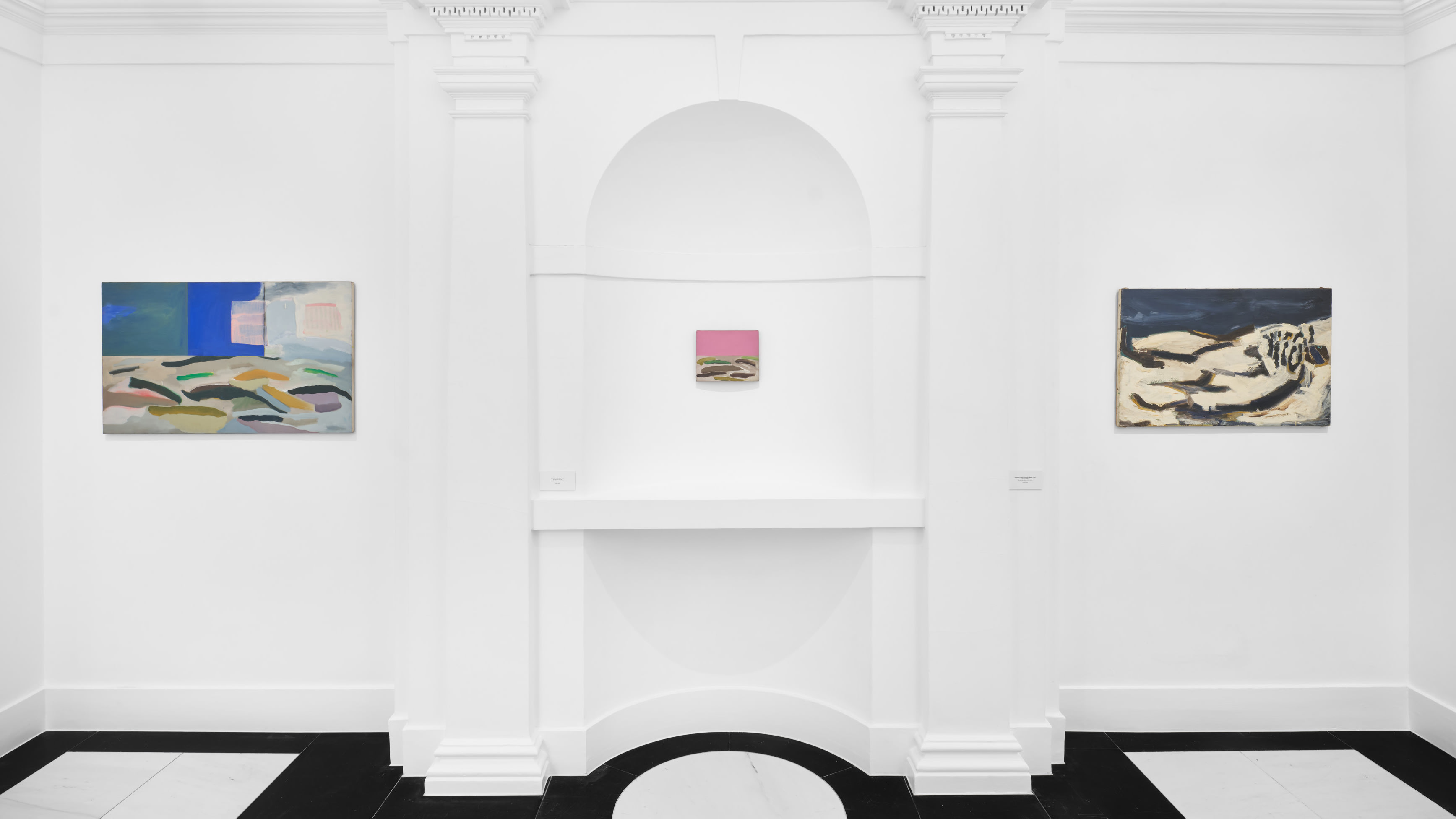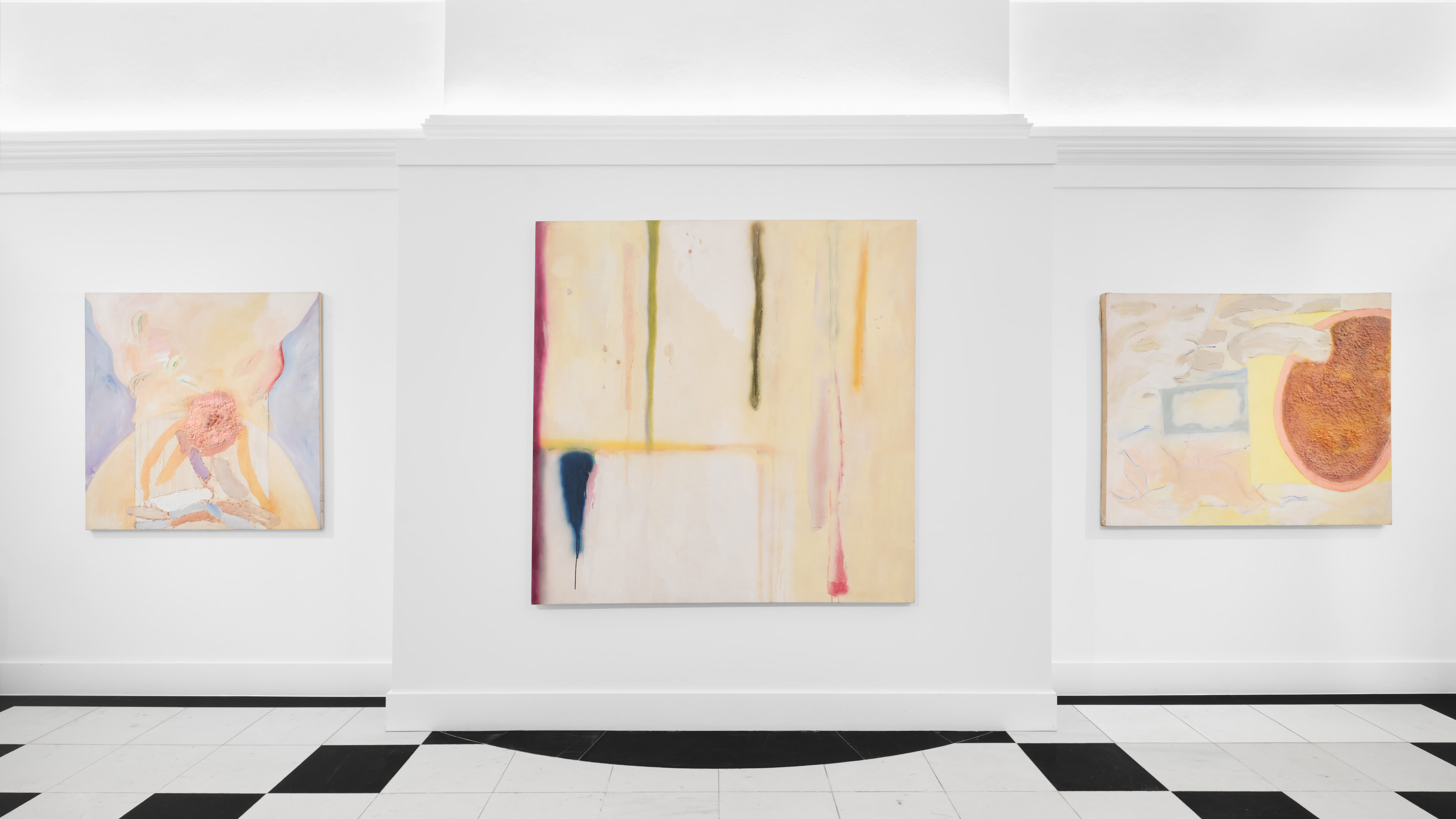How often have I felt when speaking with others that we only scratch the surface of what’s truly meant and felt? It’s most likely the reason that I paint... to be able to say more than I can possibly say at any one time.
— Joan Snyder



Snyder’s celebrated Stroke paintings enabled the artist to depict the paint stroke while dissecting its many layers to reveal the ‘anatomy of a painting.’ As Snyder says, ‘the paint became the subject, the marks, my voice.’
A formative painting in this series, Veiled Strokes (1969) embodies the artist’s nascent interest in the stroke. Each mark has a unique character: solid and resistant, veil-like and bleeding, yet transparent. Offering a strong sense of verticality, the slightly tapered strokes appear as enlarged drips of paint.
Veiled Strokes, 1969

Each stroke is just that
Each stroke is a landscape
Each stroke is an analysis
Each stroke is a language
— Joan Snyder
Flock Painting I, 1969
Acrylic and flock on canvas
124.46 x 154.94 cm (49 x 61 in)

Wild Strokes Hope, 1972
Oil and acrylic on canvas
152.4 x 304.8 cm (60 x 120 in)

I wanted more in a painting, not less. I wanted to tell a story, have a beginning, a middle, an end, even resolution… to be able in one painting to have all of this…
— Joan Snyder
An impassioned exploration of the possibilities of the paintbrush, Little Yellow (1971) is a rare example of a Stroke painting that has remained in the personal collection of the artist since its creation. Her treatment of the mark oscillates between opaque swathes of pigment, pastose bar-like strokes and looser, more fluid forms from which paint drips down the canvas beneath.
Little Yellow, 1971
Oil, acrylic, pencil and spray enamel on canvas
60.96 x 60.96 cm (24 x 24 in)
In these works, and across Snyder’s life’s practice, beauty in nature, visceral color, pain, and loss heave back and forth.
— Devorah Lauter, Artnet


Baby Grand, 1981
Oil, acrylic, burlap, paper on canvas
22.86 x 60.96 cm (9 x 24 in)

Whole Segments, 1970
Oil, acrylic, pearlescent spray paint and pencil on canvas
182.88 x 365.76 cm (72 x 144 in)

To Transcend / The moon, 1985
Oil and acrylic on canvas
152.7 x 245.1 cm (60.1 x 96.5 in)


Body & Soul, 1997–1998
Oil, acrylic, fabric, paper mache, glitter, straw and plastic grapes on canvas
167.64 x 198.12 cm (66 x 78 in)

Apple Tree Mass, 1983
Oil, acrylic, paper mache, wood, paper, cloth, pencil and ink on linen
69.96 x 182.88 cm (24 x 72 in)

Her work might hang on a wall, but it pushes itself outwards into the world, disrupting the space around it as well as the process of making art itself.
— Caroline Roux, Financial Times

Building a vocabulary of recurring personal motifs – from roses and breasts, to ponds and mud, totems, screaming faces, grapes, scrawled words, cherry trees and moons, pumpkins and sunflowers – Snyder develops a complex materiality through an additive process of collaged materials. A symphony of dried plants, burlap and straw are caught in the flow of paint – an eclectic approach to materiality that is closely aligned with the artist’s feminist sensibilities.
Painting at the Pond, 2024
Oil, acrylic, paper mache, burlap, rose petals and buds, straw, paper and ink on canvas
137.16 x 167.64 cm (54 x 66 in)

Often formed by pouring paint directly onto the canvas, the ponds in Snyder’s recent work emulate deep pools of water seen from above. Art historian Susan L. Aberth connects the motif to Snyder’s impulse towards mysticism, describing the ponds as ‘nature’s scrying mirrors’.
Come to Pearl Pond, 2024
Oil, acrylic, burlap, paper mache, poppy pods, rosebuds, dried flowers, straw, paper and ink on canvas in two parts
121.92 x 121.92 cm (48 x 48 in)

Written across the walls of this career-spanning show is a lifetime of emotions and feelings, of memories and experiences, in big bursts of shape and colour.
— Time Out

The diptych-like structure of Deepest Spring (2024) sets up a series of dialogues across its two halves; between figuration and abstraction, collage and paint, symbolism and formalism. The diptych format – with its religious art-historical references – casts the painting as a kind of personal reliquary in which Snyder's own repertoire of motifs and materials takes on a heightened, mystical resonance.
Deepest Spring, 2024
Oil, acrylic, paper mache, burlap, rose petals and colored pencil on canvas in two parts
127 x 152.4 cm (50 x 60 in)

Selfie (2024) evokes the photograph taken of and by oneself using a phone camera; a self-portrait. The painted figure gestures to her daughter's stick-figure drawings that influenced the artist in the 1980s. The face, with its mouth stretched open, recalls the screaming head that appeared in the same decade as an expression of grief and rage. Recontextualised here within the bouquet of roses that comprise the figure’s head, the motif takes on new meaning. Its expression has softened, and it is perhaps a song that bursts forth from its open mouth. The form of the figure is echoed by that of a weeping cherry blossom tree to its right. Instead of the barren lifeless trees that populate Snyder’s works from the 1980s, here she offers us the hopeful image of a tree in full bloom.
Selfie, 2024
Oil, acrylic, paper mache, rose petals, mud, paper and pastel on linen
137.16 x 198.12 cm (54 x 78 in)
Publication

Joan SnyderBody & Soul
Thaddaeus Ropac
Texts: Susan L. Aberth and Emily LaBarge
180 pages
English
ISBN 978-1-7396516-7-1
Published 2024
€ 60.00


































































































































































































